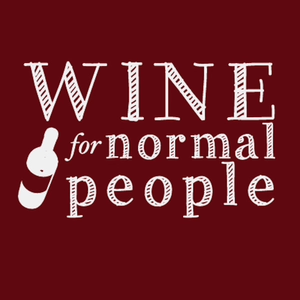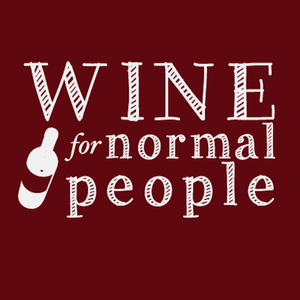
Wine for Normal People
Elizabeth Schneider


6 Listeners
1 Comment
All episodes
Best episodes
Top 10 Wine for Normal People Episodes
Goodpods has curated a list of the 10 best Wine for Normal People episodes, ranked by the number of listens and likes each episode have garnered from our listeners. If you are listening to Wine for Normal People for the first time, there's no better place to start than with one of these standout episodes. If you are a fan of the show, vote for your favorite Wine for Normal People episode by adding your comments to the episode page.
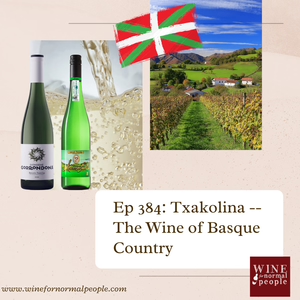
Ep 384: Txakolina --The Wine of Basque Country
Wine for Normal People
07/28/21 • 38 min
The Basque Country in northeastern Spain lies on the Bay of Biscay and abuts the Pyrenees Mountains, a mere 18 mi/30 km from the French border. Until about a decade ago, this area was relatively unknown as a wine region. But with the rise of Basque cuisine, an increased interest from wine buyers in native varietals, and a desire for lower alcohol, thirst-quenching wines, Txakolina (chock-o-LEEN-ah), a white, high acid, spritzy wine started to get attention. The phenom started in places all over the United States (which boasts a Basque population of more than 50,000 people), then the UK and Japan, now small quantities of wine find their way to many other countries around the world.
Map of Basque Country: Vineyards.com
In this show, we discuss this historic region, with its own language, culture, and wine traditions. We talk about how the modern wine industry was renewed, and what you can expect from these delicious, refreshing (mainly white) wines. If you haven’t had these wines or heard of them, this should will give you a good foundation to learn about them and appreciate all that it took for them to make it to your table!
Here the show notes:
- We give an overview of the Basque region (Euskadi), and the language of Euskera, one of the oldest spoken languages with no link to any other known language
- We discuss the quirky naming convention of the wine of this area, the original name of called txakolin and the meaning of txakolina "the txakolin" – a term was used from middle of the 18th century onwards and how Txakoli was a misspelling used after 1985. (Source: Wikipedia, originally from the Academy of Basque Language)
- The wine is called chacolí in Spanish
- We spend time on the history of Basque country, with a focus on the independent spirit of the Basque people. We discuss the political discord in the region, especially the difficulties with the Basque Separatist Movement. We tie in wine—discussing the importance of the rise of Michelin-starred chefs in the Basque region, the interest of importers like Jorge Ordoñez who imported cases of Txomin Etxaniz to the US in the early 1990s, and how sommeliers and others had growing interest in native grapes
Photo: Guggenheim Museum, Bilbao in Basque Country
- Location: We review where Basque Country is...
- Northern Basque Country: The French part in the Pyrénées-Atlantiques department of France
- Southern Basque Country/El País Vasco of Spain, Basque Autonomous Community: including Álava, Biscay, and Gipuzkoa
- Other areas that make Chacolí (I’m spelling it this way because they are Spanish areas) are Cantabria and Burgos
- Land and climate: We mention features like the Cantabrian Mountains, vineyards near the coast surrounding Bilbao, and vineyards toward the Ebro Valley and Rioja. Vineyards are terraced and on hillsides, some quite steep. We talk about the wet Atlantic climate of the reigon and its effect on the grapes.
Photo: Bodega Doniene Gorrondona
- Grapes: The main grapes are Hondarrabi Zuri (Courbu blanc and here is the link to the blog we mention), Hondarrabi Zuri Zerratia, Hondarrabi Beltza (a red grape for reds and rosés), Also allowed: Bordeleza Zuria/ Mune Mahatsa (Folle Blanche), Izkiriota Ttipia (Petit Manseng), Izkiriota (Gros Manseng), Petit Corbu, Txori mahatsa (Sauvignon Blanc), Chardonnay, Riesling
- Here’s the article I mention in the show about rosé being a creation for the American market...
- Vineyard and winemaking. We discuss the parras – the high pergolas that help keep the airflow through the canopy. We talk about the mainly modern winemaking facilities and methods, but how some of the producers are working with longer lees aging, aging in wood and concrete, and blending. We explore the technique of making the wine under a blanket of nitrogen to ensure spritz in your glass and how it is pour from shoulder height to enhance the fizz in the glass.
Txakolina Vineyard Photo: Josu Goñi Etxabe, Public domain, via Wikimedia Commons
Finally, we discuss the Denominaciones de Origen:
Getariako Txakolina or Txakoli de Getaria, (Chacolí de Guetaria -Spanish), is the most important, oldest, and most prolific DO, yet the smallest geographically. The wines are softer and riper, with less bitterness and great acidity. They nearly always have spritz.
Bizkaiko Txakolina or Txakoli de Bizkaia - (Spanish is Chacolí de Vizca...

2 Listeners
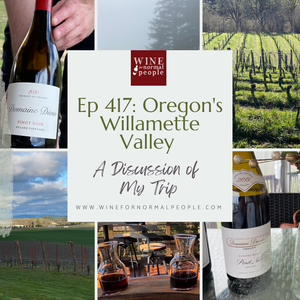
Ep 417: Oregon's Willamette Valley -- A Discussion of My Trip
Wine for Normal People
03/08/22 • 52 min
After a trip to the Willamette Valley in Oregon, M.C. Ice and I have a casual discussion on "What I learned on my school vacation" 😂 -- a few details of the region, specifics on the wineries and sub-regions, and ultimately (apologies, but Oregon super fans won't want to hear this) my opinions on the challenges I have with the Pinot Noir of the region and how I feel that Chardonnay may be Willamette's best grape.
View from Beaux Frères
Remember -- the show is based on my opinions with some facts (as I have always said, Wine For Normal People is not a study guide for an exam nor is it impartial. I offer facts but always with my spin or interpretation on it. If you don't like it, that's fine, but never has this show pretended to be a journalistic look at regions or a show that doesn't give my spin on things. In a show like this, it's especially important to remember that).
View from a high point of the Dundee Hills
Regions mentioned:
- Dundee Hills
- Yamhill-Carlton
- Chehalem Mountains and Ribbon Ridge
- Eola-Amity Hills
- McMinnville
- Willamette Valley
- Van Duzer Corridor
- The Rocks District of Milton-Freewater AVA (for that epic Syrah)
Wineries mentioned:
- Domaine Divio
- Beaux Frères
- Lenné
- Domaine Drouhin
- Purple Hands
- Le Cadeau (the Syrah I mentioned is their other label, Aubichon)
- Methven Family Vineyards
- Coeur de Terre
The area is gorgeous, the people very kind, but ultimately not much has changed for me from the original Oregon podcast. I remain skeptical of the value for money that Oregon offers and the quality and consistency of the Pinot Noir. I have become a big fan of the Chardonnay of the area, and I think Gamay has a big future here but the region is still young and it has staked its entire reputation on Pinot Noir, so we'll see what happens in the years to come.
One final shoutout to Caravan Coffee, for the best cup I've ever had in the US!!
*All photos (C)Elizabeth Schneider
____________________________________________________________
Thanks to our sponsors this week:
Our new sponsor: Wine Spies!
Wine Spies uncovers incredible wines at unreal prices - on Zinfandel, Barolo, Champagne...you name it - up to 75% off! It’s not a club and there’s no obligation to buy. They have a build-a-case option, so you can mix and match wines while enjoying free shipping on every purchase. Visit www.winespies.com/normal you’ll get $10 credit to use on your first order! Check them out today!
If you think our podcast is worth the price of a bottle or two of wine a year, please become a member of Patreon... you'll get even more great content, live interactions and clas...

2 Listeners
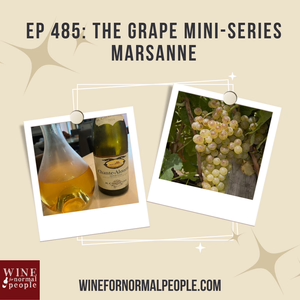
Ep 485: The Grape Miniseries -- Marsanne
Wine for Normal People
08/14/23 • 39 min
This time we dive into one of the three main grapes of the Northern Rhône: Marsanne. Related to Roussanne, the grape with which it is almost always blended, this grape reaches its heights in the wines of Hermitage in northern Rhône and does exceptional things around the world from Victoria and South Australia, to the US, to New Zealand and South Africa.
Photo: Chante-Alouette from Chapoutier, the wine we mention in the show. Credit: Wine For Normal People
Although not a grape you will encounter as a standalone varietal that often, its contribution to the great whites of the Rhone can’t be underestimated. This grape is vital to understand if you are interested in diving deeper into the world of Rhône whites (which you definitely should do!).
Full show notes are on Patreon. Become a member today! www.patreon.com/winefornormalpeople
_______________________________________________________________
I love my exclusive sponsor, Wine Access, my go-to source for the best selection of interesting, outstanding quality wines you can’t find locally.
Go to www.wineaccess.com/normal to join my co-branded wine club with Wine Access and www.wineaccess.com/wfnp so see a page of the wines I'm loving right now from their collection. Get 10% your first order with my special URL. Check out Wine Access today!
To register for an AWESOME, LIVE WFNP class with Elizabeth go to: www.winefornormalpeople.com/classes
Sources used in the show:
- Wines of the Rhone, Matt Walls (also listen to Episode 458 with Matt Walls)
- Wine Grapes, Dr. José Vouillamoz, Jancis Robinson, and Julia Harding
- Grapes & Wines, Oz Clarke and Margaret Rand
- Tablas Creek Blog (Also, episodes 162, 281, 440 with Jason Haas of Tablas Creek)
- Tahbilk Winery Site
- The Wine Cellar Insider
1 Listener
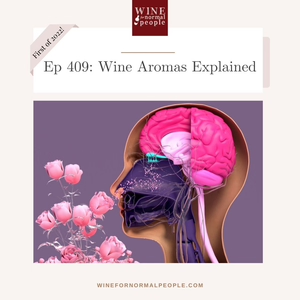
Ep 409: Wine Aromas Explained
Wine for Normal People
01/13/22 • 36 min
Photo: Pixabay
Note: I recorded this right before I got sick so I sound a little 'throaty' but I hope you'll enjoy the show nonetheless!
For the first show of 2022, we start out with a dorky one and answer the question:
Where does aroma come from and are the things people describe in wine like roses, smoke, and pepper real or total BS?
We take the questions head on and give some answers that may surprise you! Enjoy and thanks for your continued support of the show and all we do!
Here are the show notes:
We start with the basic, defining aroma, as I do in the Wine for Normal People book: The smells unique to the grape variety, demonstrated in a varietal wine in its youth.
We discuss perception, wine tasting, and then I review some very cool findings from this article, “Aroma Compounds in Wine” By Fengmei Zhu, Bin Du and Jun Li, Published: October 19th 2016
At a high level we talk about aromas from the grape, from yeast and enzymes, from amino acids, and those from malolactic fermentation. We talk about the effects of weather and soil briefly as well.
Then we go through the laundry list of compounds in wine, and what each brings to the aroma, bouquet, and flavor:
Terpenes: In grape skins also in fruits, flowers, leaves of some plants. Big component of aromatic whites – Muscat, Gewurztraminer, Muscat, Riesling. Includes:
- Linalool: When in contact with other things in the wine, makes lavender, orange blossom, lily, bay leaf notes
- Geraniol: Rose petal smell
- Nerol and citronellol:Floral, citrus notes, also in flowers and fruit
- Limonene and citral: Found in citrus peel
- Hotrienol: Elderflower, gooseberry
- 1,8-cineole and alpha-pinene:Eucalyptus, garrigue (airborne and can cling to the skin of grapes)
Rotundone: In skins, aroma of peppercorns, particularly white pepper
Photo: Pixabay
Aldehydes:
- Hexanal and hexenal: Fresh cut grass, tomato leaf
- Vanillin:Vanilla beans, vanilla
- Benzaldehyde:Bitter almond or marzipan in Italian white wines
- Furfural: Dried wood, caramel, oak
Pyrazines/ Methoxypyrazines:
- Green bell pepper, herbaceous notes
Esters: Created by reactions between alcohols and acids
- Primary fruit aromas like apple, orange, citrus, banana, pear
Photo: Pixabay
Ketones and diketones:
- Beta-ionone: Violets, dark flowers
- Diacetyl: Butter, creaminess in wine - byproduct of malolactic fermentation. When combined with new American oak with its vanilla- nut notes - like buttered popcorn
Thiols/Mercaptans: Volatile sulfur compounds in grapes, released by fermentation (when bad – like garlic or onion!)
- 3MH (3-mercaptohexan-1-ol):Passion fruit
- 3MHA (3-mercaptohexyl acetate):Guava and gooseberry
- 4MMP (4-mercapto-4-methylpentan-2-one): Blackcurrant (Cab)
Lactones
- Sotolon:Sauternes, Madeira -- either Botrytis or age has an effect here - spice, nuts, maple syrup
- Octalactone: Coconut notes
Phenols are derived from oak aging:
- Guaiacol: Smoke, roasted, toasty notes
- Eugenol: Clove
Other common wine aroma compounds
- TDN (1,1,6-trimethyl-1,2-dihydronaphthalene): Petrol or kerosene in Riesling
- Noriosoprenoids: Spice, raspberry, rose, vanilla
Photo: Pixabay
What's the point of this show? Forget all the technical terms and just know: what you are tasting and smelling is based on something REAL -- not some nonsense made up by wine snobs. There is a legitimate reason for why wine smells the way it does!
_____________________________________________
If you think our podcast is worth the price of a bottle or two of wine a year, please become a member of Patreon... you'll get even more great content, live interactions and classes!
www.patreon.com/winefornormalpeople
To register for an AWESOME, LIVE WFNP class with Elizabeth go to: www.winefornormalpeople.com/classes
_______________________________...

1 Listener
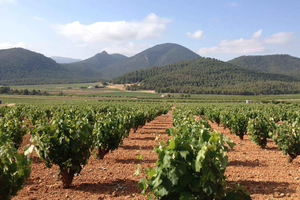
Ep 326: The Best Spanish Wines You've Never Heard of -- Jumilla and Yecla
Wine for Normal People
05/19/20 • 38 min
Tucked into a small corner of southeast Spain is one of the greatest sources for delicious, multi-layered, and decadent reds you’ll find. In the province of Murcia, at latitude 39 ̊N lay two regions of Monastrell (Mourvèdre) production that have quietly churned out wine for more than 3,000 years: Jumilla (joo-ME-yah) and Yecla (YAY-clah).
Today, these regions are magnificent but receive so little press that we can get exquisite bottles that have the fullness, richness and depth for less than US$20.
In the podcast, we take you through the wine history of the region --from the early days with the Phoenicians to the Romans and then the Moors, and then a few strange brushes with the phylloxera root louse that at first propelled the region’s wines, then decimated the land and ultimately saved this area from a fate of nasty bulk production to make it a quiet haven of powerful reds.
We discuss the conditions in Murcia, discuss Bullas, a small Denominacíon de Origen and then we move to the big guns of this area: Jumilla and Yecla.
Jumilla
Jumilla is the best area quality in Murcia and also makes the most wine. Vineyards are spread across a wide valleys and plateaus surrounded by mountains. A few geological and climate facts:
- The high elevation of the vineyards -- between 1,300 -2,600 ft (400 -800 m) make it possible for grapes to cool at night and maintain acidity.
- The soils here are dark and have a high limestone content. They’re permeable but have good moisture retaining properties, allowing the vines during the harsh summer droughts.
- This is a very difficult place to grow things – it’s a harsh, dry, continental climate that is tempered a bit by Mediterranean breezes but is brutal in its dry heat.
Jumilla is one of Spain’s oldest DOs – its historical legacy as a high-quality wine producer is well known in its native land. It now makes whites, reds, and rosés, although the reds are the flagship for the region.
- Red grapes include: Monastrell, Tempranillo (called Cencibel here), Garnacha Tinta, Syrah, Cabernet Sauvignon, Merlot, and Petit Verdot. The French varietals were added to the Monastrell to create more dimension in the finished wine (read: international appeal). This has been critically acclaimed, however some of it muddies the character of the grape.
- White grapes include: Aíren, Macabeo, Pedro Ximenez, Malvasia, Chardonnay, Sauvignon Blanc, Mosacatel de Grano Menudo
- Although not mentioned in the podcast, the Jumilla DO has several areas it draws from: Jumilla, Montealegre, Fuenteálamo, Tobarra, Hellín, Ontur, and Albatana. 40% of the wine is from Jumilla proper.
Monastrell represents 85% of the vines planted and 80% of any blend must be this grape. The character of the wine is superb: it tastes like dark fruit, earth, and minerals with a brambly, gamy character. With age, these flavors mellow to be more like dark soil, coffee and spice.
Although it isn’t prevalent, Jumilla makes rosé from 80% Monastrell too -- in the best versions it’s similar to the rosé of Bandol, in Provence, France with some acidity and tannin and, from a careful producer, the opportunity to potentially have a longer life than 1 year.
Modern technology, good farming and a consistent climate mean there isn’t a lot of vintage variation here although the region does have aging classifications similar to Rioja:
- Vino joven ("young wine") or Sin crianza: little, if any, wood aging.
- Crianza:
- Reds: aged for 1 year total -- at least 6 months in oak, 6 months in the bottle.
- Whites and rosés: at least 1 year with at least 4 months in oak.
- Reserva:
- Reds: aged for at least 2 years -- at least 12 months in oak, 12 months in the bottle.
- Whites and rosés: aged at least 18 months with at least 6 months in oak.
- Gran Reserva: Made only above average vintages.
- Reds: 4 years aging, 12 months of which in oak and a minimum of 36 months in the bottle.
- Whites and rosés: aged for at least 4 years with at least 6 months in oak
Yecla
Towards the end of the show, we discuss the smallest and northernmost wine zone in Murcia, Yecla. This area is landlocked by other DOs: Jumilla DO to the southwest, Almansa DO to the north, and Alicante DO to the east. It’s 50 miles (80km) inland and represents a transition from more coastal Mediterranean influences to hotter, arid continental conditions.
Yecla is similar to Jumilla in that its altitude allows the grapes to maintain acidity at night, creating balance in the wines.
- White grapes: Airen, Macabeo, Merseguera, Malvasia, Moscatel de Grano Menudo, Sauvignon Blanc, Chardonnay. These wines are usually blended. A small amount of sparkling wine is also made here.
- Red grapes: similar to tho...
1 Listener
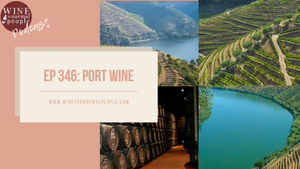
Ep 346: Port Wine
Wine for Normal People
10/12/20 • 59 min
Port is an historical, complex, and sometimes confusing wine, but it is more than worth your time to learn about. M.C. Ice go over everything from the vineyards of the Douro, to the history of this wine (with geopolitical implications), to how it's made, and the array of styles. There's something for everyone in the world of Port and after this show, you should be able to figure out which is for you!
Here is the written primer to go along with the show...
The Basics: What is Port?
Port is a Portuguese fortified wine, meaning you add distilled grape spirit, or brandy, to the wine at some point during production. A wine is technically only Port if grapes are from the Douro Valley in northeast Portugal and winemaking takes place there or in the area surround the city of Porto on the Atlantic Coast. There are tons of styles and flavors of this wine – there’s something for everyone.
Douro Valley: The Vineyards
The Douro Valley wine region follows the path of the Douro River as it comes out of Spain into Portugal. The region goes west through rugged, remote, steep and terraced granite mountains of northern Portugal, past the city of Porto into Atlantic Ocean. There are three official zones of the Douro Valley: the Baixo (lower) Corgo, the Cima (higher) Corgo and the Douro Superior
- Baixo Corgo is the westernmost zone and is cool, rainy and the sub region with the most vineyards.Often these grapes are for cheap ruby and tawny Port
- Cima Corgo is upstream from the Baixo Corgo and is where the best vineyards for Port are located. Hotter and drier than Baixo, these excellent grapes are used for Vintage, Reserve, aged Tawny, and Late Bottled Vintage Ports
- Douro Superior is the easternmost zone, going right up to the Spanish border. It has a lot of land but is least developed. It is the hottest, driest area, and a bit flatter
Land and Climate
The Douro has hot, dry summers and steep rocky hillsides bordering the Douro River and its tributaries. The thin, poor schist and granite soils force the grapes to dig deep into schist to look for water and force humans to build terraces to do viticulture: 2/3 of vineyard are on slopes with 30%+ grade.
The Grapes
- Reds: Producers are permitted to use more than 80 red varieties but 5 are widely used: Touriga Nacional, Touriga Franca, Tinta Barroca, Tinta Roriz (Tempranillo), Tinta Cão. The best wines are blended from low yielding vines with grapes that are small with thick skins and good acidity levels. The grapes here, with the exception of Tempranillo, are indigenous and suited to the hot, dry conditions of the Douro. There is nothing else that tastes like these blends
- Whites (30 allowed): Gouveio, Malvasia Fino, Moscatel, Vinosinho, Rabigato, Esgana-Cão (Sercial of Madeira, dog strangler), others
History of Port: Most of the information on Port was on Taylor Fladgate’s excellent site.
Winemaking: The Steps
- Grow grapes in Douro. The IVDP (Instituto dos Vinhos do Douro e Porto– Port and Douro Wines Institute)uses the beneficio system (similar to the Échelle des Crus in Champagne) to classify vineyards with a grade that will determine the quantity of Port Wine that can be made from each parcel.
- Put the grapes in a vat (different varieties are usually co-fermented). Stomp them by foot or press them and then start fermentation. When you get to the sugar level you want in the finished wine, run the wine out of the lagar into a vat. To that runoff of juice, add aguardente to kill the yeast and stop fermentation, leaving some sweetness. The resulting wine is usually 19% to 20% alcohol
- Let the wine chill out in Douro until spring, evaluate it for what style of Port it will make and then take the wine to lodges at Vila Nova de Gaia near the city of Porto to be blended, aged, bottled and then sold.
- The real magic is in the ageing…
Ageing & Port Styles
Ports differ because of the quality of the vineyards/grapes, the makeup of the blend, and the ageing regimens they go through. Age softens the bitter, astringent tannins and with time older Ports become brownish in color, soft in tannin, and full of interesting aromas and flavors.
Port is classified by how long and WHAT it’s aged in: Wood or bottle
- Wood Aged Port is matured in wooden barrels. They’re permeable to air so this is called oxidative aging. These wines lose color faster than bottle aged Ports.
- Bottle Aged Port is aged in barrel for 2 or fewer years. It then goes into a bottle and the buyer ages it in their own cellar. Vintage Port, the finest of all Ports, is made this way.
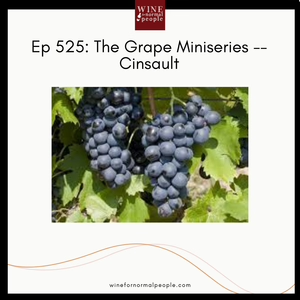
Ep 525: The Grape Miniseries -- Cinsault
Wine for Normal People
06/25/24 • 40 min
Cinsault or Cinsaut is a grape you’ve probably rarely heard of, but if you drink Provence or southern French rosé you have it all the time! The grape is planted widely in the south of France, but the grape’s biggest champions are in the New World, where Cinsault is getting new attention for making light, acidic, refreshing reds.
This is a warm-climate grape, that actually thrives in dry and hot places. This grape is essential to our changing climate -- it retains acidity with low sugars even in the hottest conditions, providing a lifted, bright note to reds and rosés.
Photo: Carignan. Source: Vins-Rhone
___________________________________________________
With typical aromas of ripe red berry fruit, like raspberry, strawberry and cherry, warm spice, and violet or dark flower notes and floral, strawberry, peach, and tea leaf notes in rosé, this is a lovely grape if made well.
Where can you find Cinsault as a varietal wine or a big player in a blend?
- France: Southern Rhône, Provence and the Languedoc have big plantings of Cinsault
- Other Countries: Italy, Spain, North Africa, Chile, Australia
Then we get to the most impassioned fans of Cinsault...
Lebanon: In the mountainous region of the Bekaa Valley, Cinsault has thrived for decades. The famed Chateau Musar red relies on Cinsault in its most prestigious blend
________
California, USA: California has the oldest Cinsault vines in the world in Lodi, California at the Bechthold Vineyard which was planted in 1886.
________
South Africa saw growth in Cinsault in the mid 1800s because growers knew it could handle the hot, arid climate around Cape Town. It is a parent of Pilotage. I mention is Natte Valleij as a great Cinsault producer. Other producers from many regions in South Africa are also doing great things with Cinsault.
Full show notes and all back episodes are on Patreon. Become a member today!
www.patreon.com/winefornormalpeople
_______________________________________________________________
Check out my exclusive sponsor, Wine Access. They have an amazing selection -- once you get hooked on their wines, they will be your go-to! Make sure you join the Wine Access-Wine For Normal People wine club for wines I select delivered to you four times a year!
To register for an AWESOME, LIVE WFNP class with Elizabeth or get a class gift certificate for the wine lover in your life go to: www.winefornormalpeople.com/classes
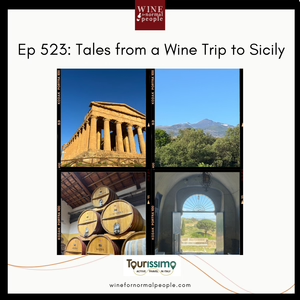
Ep 523: Tales from a Trip to Sicily
Wine for Normal People
06/11/24 • 51 min
This show chronicles my recent trip with a group of Patrons to Sicily with my travel partner tour with Tourissimo. I take you through our odyssey, which had us traversing the entire island from west in Palermo to the center of the island to the southeast in Vittoria to Mount Etna.
I discuss the themes I noticed throughout like interesting climatic quirks that the quality regions share, the amazing culture and hospitality, and the uniqueness of the wines on this beautiful island and more.
I hope you enjoy this recap and it gives you a flavor for what Sicily is like and how awesome it is from a wine, people and place perspective!
A special thanks to the Patrons who went on this trip, and to my amazing travel partners, Heather and Beppe, the owners of Tourissimo for making this journey so special!
Full show notes and all back episodes are on Patreon. Become a member today!
www.patreon.com/winefornormalpeople
_______________________________________________________________
Check out my exclusive sponsor, Wine Access. They have an amazing selection -- once you get hooked on their wines, they will be your go-to! Make sure you join the Wine Access-Wine For Normal People wine club for wines I select delivered to you four times a year!
To register for an AWESOME, LIVE WFNP class with Elizabeth or get a class gift certificate for the wine lover in your life go to: www.winefornormalpeople.com/classes
Show more best episodes

Show more best episodes
Featured in these lists
FAQ
How many episodes does Wine for Normal People have?
Wine for Normal People currently has 621 episodes available.
What topics does Wine for Normal People cover?
The podcast is about Alcohol, Lifestyle, Podcasts, Wine, Education, Arts and Food.
What is the most popular episode on Wine for Normal People?
The episode title 'Ep 384: Txakolina --The Wine of Basque Country' is the most popular.
What is the average episode length on Wine for Normal People?
The average episode length on Wine for Normal People is 45 minutes.
How often are episodes of Wine for Normal People released?
Episodes of Wine for Normal People are typically released every 7 days.
When was the first episode of Wine for Normal People?
The first episode of Wine for Normal People was released on Jan 8, 2011.
Show more FAQ

Show more FAQ
Comments

@anonymous
Jul 9
Like
Reply
